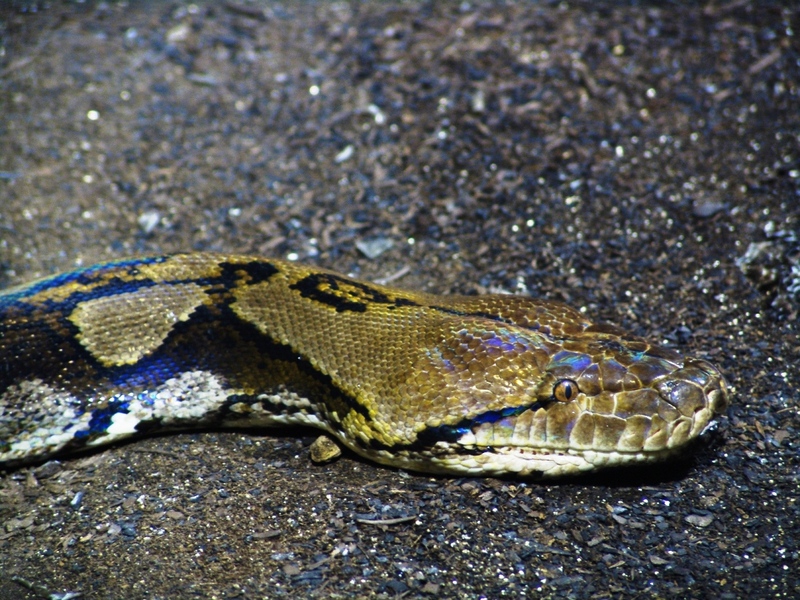Reticulated Python
From Wikipedia, the free encyclopedia
[Photo] Reticulated Python at Wilmington's Serpentarium. Date: 2 July 2005. Photo by http://commons.wikimedia.org/wiki/User:Danleo | Permission is granted to copy, distribute and/or modify this document under the terms of the GNU Free Documentation License, Version 1.2 or any later version published by the Free Software Foundation; with no Invariant Sections, no Front-Cover Texts, and no Back-Cover Texts. A copy of the license is included in the section entitled "GNU Free Documentation License". |
The Reticulated Python (Python reticulatus), with a maximum recorded length 28 feet, is the longest existing snake species. At this length it may have been as heavy as 200 kg (440 lb). However, this species is relatively slender and long, and therefore not the largest: the Green Anaconda can be roughly twice as heavy at the same length. Those who work with reticulated pythons often cite an unusual level of intelligence and awareness compared to other species.
The reticulated pythons's appearance is a complex geometric pattern that incorporates numerous different colors. The back typically has a series of irregular diamond shapes which are flanked by smaller markings with light centers. This species has a wide distribution, variations of size, color, and markings. Two subspecies currently exist, Python reticulatus jampeanus (Jampea Retics), and Python reticulatus saputrai (Selayer retics). It is an egg layer that lays between 60 and 100 eggs, at an incubation temperature of 88-90 °F (optimal), these eggs take an average of 88 days to hatch.
Although their interactivity and beauty draws much attention, some feel they are unpredictable. Attacks are rare, but the species has been responsible for several human fatalities in both the wild and captivity. This species of snake is one of the few that have documented, but not verified, cases of eating people. Given maximum size, it is possible, although likely exceedingly rare.
In Captivity
Reticulated pythons have increased in popularity in the pet trade largely due to increased efforts in captive breeding and selectively bred mutations such as the albino and "tiger" strains.
Inexperienced owners can enable snake escapes, sometimes causing injury to the owners themselves, other pets, and people living nearby. For the health and safety of both the snake and humans, reticulated pythons should only be kept by experienced keepers equipped to handle large constrictors. Feeding large snakes is particularly hazardous, and a second person should be available during this time to assist in any emergency or call for help.
Reticulated pythons can make great and extremely rewarding captives, but the keeper should have previous experience with large pythons to help ensure safety to both animal and keeper. They do not attack humans by nature, but will bite and possibly constrict if they feel threatened or mistake a hand for food. While not poisonous, large pythons can inflict very serious bites, sometimes requiring stitches.
Variations
Several variations of the Reticulated python are currently being bred in captivity, including the tiger, super tiger, albino (white, lavender, dark lavender, and purple phase), albino tiger, albino super tiger, genetic stripe, sunfire, golden child (this morph may be soon renamed), calico, ivory/white flame, and many others.
Farming
Within the past 20 years, reticulated python farms have grown in many Asian countries, including Indonesia. It is rumored that European settlers introduced them to the region in 1558. Current estimates state that there are roughly 5,400 reticulated python farms throughout Southeast Asia. In countries such as Indonesia, reticulated pythons are said to outnumber humans 15 to 1. Native peoples first gained interest in farming them when they realized the skin could easily be sold for profit in the snake skin industry. Reticulated python skins are popular sources for purses and boots, such as the typical snake skin cowboy boot. Prada has also used reticulated python skins on some of their purses. The meat of these snakes is also considered a delicacy amongst local peoples and sells for as much at 50 USD per kilogram.
http://en.wikipedia.org/wiki/Reticulated_Python
| The text in this page is based on the copyrighted Wikipedia article shown in above URL. It is used under the GNU Free Documentation License. You may redistribute it, verbatim or modified, providing that you comply with the terms of the GFDL. |
|

